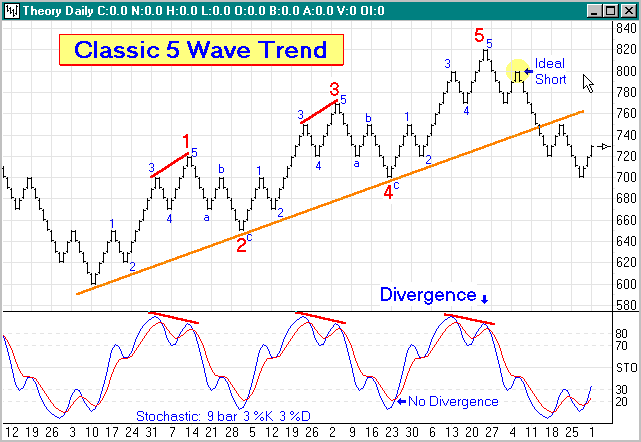by Howard Arrington R.N. Elliott studied price movement in the markets and observed patterns that repeat themselves. He used this discovery to make accurate forecasts in the stock market. To the untrained eye, market movement may appear random and unrelated. In reality, the markets are tracing out patterns that you can learn to recognize and profit from. Mr. Elliott named this discovery the 'Wave Principle', but died before his work became well known. In the late 1970's Robert Prechter and A.J. Frost brought Elliott's work out of obscurity in their book 'Elliott Wave Principle'. This article offers a few basics in understanding the Wave Principle. Society behavior trends and reverses in recognizable patterns. This principle is found in market behavior because investors act and react to transaction information. The behavior forms repetitive patterns, and because the patterns are repetitive, they have predictive value. Elliott identified thirteen patterns that recur in the markets. He then assembled these patterns or waves into larger versions of the same patterns. These became building blocks to patterns of the next larger size. The most basic pattern is a structure consisting of 5 waves. Three of the five waves are directional and referred to as Trend waves. These trend waves are separated by two interruptions that are counter trend and referred to as Retracement waves. Using T for a Trend wave, and R for a Retracement wave, the pattern can be described as T-R-T-R-T. The classic pattern is shown in this theoretical chart.
The three Trend waves are labeled 1, 3, and 5. The two Retracement waves are labeled 2 and 4. Each Trend wave has a 5 sub-wave structure and each Retracement wave has a 3 sub-wave structure. In the illustration the larger degree wave is labeled with the large red numbers. The Trend waves to labels 1, 3, 5 consist of 5 sub-waves labeled with the small blue numbers 1-2-3-4-5. The 3 sub-waves in Retracement waves to labels 2 and 4 are labeled with small blue letters a-b-c. Keep in mind that each wave is just a member of a larger structure, and conversely each wave can be subdivided into waves of a lesser degree. Basic Elliott Wave Principles: Fairly often, a retracement wave retraces a Fibonacci percentage of the preceding wave. Sharp corrections often retrace 61.8% or 50%. Sideways corrections often retrace 38.2%, particularly in wave 4. Most analysts focus on Retracement waves and measuring wave heights to forecast a price objective using Fibonacci ratios. Tip: Use Fibonacci principles to forecast a price, and use Elliott principles to determine when a wave is mature or finished. Look for correlation of the two. There will be times when market analysis is confusing and the interpretation is unclear. My advice is to leave confusing patterns alone until subsequent waves clarify the picture. The best approach is to apply deductive reasoning. Learn Elliott Wave Principles, rules and patterns, and use this knowledge to deduce what will be the likely course for the market. A primary purpose of the analysis is the determination of whether a pattern is complete, whether a wave is finished. If the market changes direction as expected, you caught the turn. If the market misbehaves, your conclusion is wrong and money at risk should be immediately reclaimed. Tip: Be patient and understand first where the market is at in the unfolding pattern, and then trade with the trend. |
